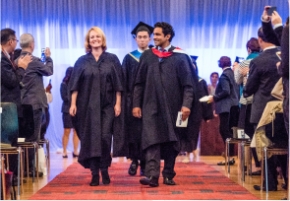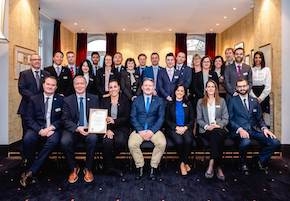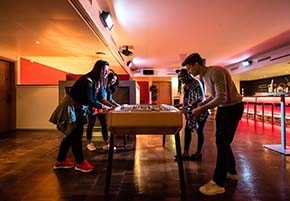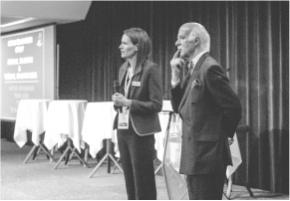- About
- Programs
- Innovation & Research
- Campus Life
- Career Services
- Admissions
- News & Events
- Alumni
Hotel Retrofitting for Sustainability: Practical Steps
Learn how hotel retrofitting sustainability improves efficiency, lowers costs, and offers strong ROI through smart upgrades and financing options.
Key Takeaways
- Hotel retrofitting for sustainability combines energy, water, materials, and operational upgrades to cut costs and meet environmental standards.
- Fast-payback measures like LED lighting and low-flow fixtures deliver immediate savings, while deeper investments in insulation and HVAC modernization provide long-term operational benefits.
- Green loans, sustainability-linked financing, government incentives, and phased implementation strategies make retrofit projects accessible to properties of all sizes.
The average hotel runs 24 hours a day. From constant energy use to laundry cycles, food preparation, waste disposal, and the production of guest amenities, the environmental footprint adds up quickly. According to industry research, hotels must reduce their carbon emissions by 66% by 2030 and by 90% by 2050 to prevent growth from translating into even greater environmental damage.
While new hotels are increasingly built with sustainability in mind, most of the world's hotel stock is already standing. That raises an urgent question: how do we make what already exists more climate-responsible?
One answer is retrofitting. Upgrading existing hotels to meet modern environmental standards can dramatically reduce emissions, conserve resources, and protect the long-term viability of the business.
What Is Hotel Retrofitting for Sustainability?
Retrofitting a hotel for sustainability means upgrading the existing property with the goal of lowering emissions and improving its overall level of sustainability.
Many hotel buildings were designed long before sustainability standards became a priority. Instead of replacing them entirely, retrofitting allows owners to modernize their operations in ways that meet today's climate goals.
While not a hotel, the Empire State Building underwent one of the most impressive examples of retrofitting. Over a decade, this iconic structure underwent a $550 million energy and efficiency retrofit that transformed it into one of the most sustainable historic buildings in the United States.
Your Hospitality Journey Starts Here
Master the art of hospitality management
Every one of the Empire State Building's 6,514 windows was upgraded onsite, reusing more than 96% of materials while quadrupling their energy performance. Alongside upgrades to lighting, HVAC, and control systems, these changes cut energy use by 38%, with a payback period of just three years.
Hotels can apply similar strategies to reduce environmental impact and operating costs. Retrofitting makes it possible for systems and day-to-day operations to meet a higher sustainability standard, even in spaces that were never designed for it.
Why Small Chains Should Invest in Green Retrofits
For small hotel chains, every operating cost matters. When energy bills go up or guest numbers drop, it can be hard to stay profitable. Retrofitting helps control those costs. By using less electricity and water, hotels spend less each month. This gives owners more financial stability, even when bookings are low.
Retrofitting also helps these properties stand out. Guests, especially younger travelers, increasingly filter options based on sustainability. A hotel that can prove its environmental improvements has a stronger chance of getting bookings over one that cannot.
Core Areas of Hotel Retrofitting for Sustainability
Retrofitting focuses on four key areas where upgrades deliver measurable results. Each subsection provides specific, actionable improvements hotels can implement at varying scales and budgets.
Energy efficiency
Hotels are some of the most energy-intensive buildings in the commercial sector. Heating, cooling, lighting, and hot water together make up the bulk of this load.
Retrofitting offers a way to reduce this energy use without disrupting operations or rebuilding from scratch. By upgrading core systems, hotels can dramatically lower energy consumption.
This could be done by:
- Switching to LED lighting and smart occupancy sensors
- Installing high-efficiency HVAC systems and improving ventilation
- Sealing windows, walls, and doors to reduce energy loss
- Modernizing laundry and water-heating equipment
- Upgrading to energy-efficient appliances and double-glazed windows
Hotels that invest in energy retrofits have been shown to cut consumption by more than 50%. That correlates directly with lower utility bills, a smaller carbon footprint, and a stronger appeal to environmentally conscious travelers.
Water conservation
Hotels use most of their water in guest rooms and housekeeping—two areas often overlooked in sustainability plans. Toilets, showers, and linens drive up consumption every day. Yet retrofitting water systems in these spaces can reduce usage significantly, without impacting the guest experience.
Common retrofits include:
- Dual-flush or low-flow toilets
- Low-flow showerheads and faucet aerators
- Mixer regulators to limit hot water use
- Housekeeping protocols to avoid unnecessary laundry
- Staff training on leak reporting and water-conscious practices
A retrofit project at a mid-sized hotel in Sussex, UK, showed that over 80% of water consumption came from guest-facing areas. With targeted upgrades, the hotel cut water use by at least 20%. Other studies suggest savings could reach up to 39%, offering both environmental and financial benefits—especially in regions with drought stress or rising utility costs.
Sustainable materials and waste reduction
Food waste and single-use plastics are two areas where smart retrofits deliver strong returns. Because of this, hotels are increasingly adopting:
- On-site composting or food digesters to reduce waste volume
- Bulk toiletry dispensers instead of single-use amenities
- Reusable items in kitchens and guest areas
- Responsible sourcing of construction and furnishing materials
Food waste digesters can cut disposal volumes by up to 80%, lower hauling costs, and create nutrient-rich compost for landscaping. Many hotels recover installation costs in 12 to 24 months. Meanwhile, replacing plastic amenity bottles with refillable alternatives has helped hotel groups like IHG eliminate over 200 million bottles per year. Properties that make this switch often reduce packaging costs by up to 60%.
Operational adjustments
Not all retrofits involve construction. In many cases, the biggest efficiency gains come from small operational changes that reduce waste and reinforce other upgrades. These process changes are low-cost, easy to implement, and essential for keeping sustainability improvements on track long-term.
Some such adjustments include:
- Smart controls that automatically adjust lighting, HVAC, and water use based on room occupancy
- Staff reporting systems for leaks, inefficiencies, or unnecessary energy use
- Optional towel and linen reuse programs for guests
- Routine audits to track energy and resource consumption
The ROI of Sustainable Retrofitting
Sustainable retrofits offer both immediate savings and long-term value. Some upgrades are quick to pay off. Swapping in LED lights or installing low-flow fixtures, for example, tends to cost less upfront and starts reducing utility bills right away.
Other improvements, like upgrading insulation or HVAC systems, require more investment at the start but also lead to bigger returns over time. These changes improve guest comfort and raise the overall value of the property.
To understand the return on your retrofitting investment, you need to track how things perform over time. Start by collecting data on your energy and water use before making any changes. This gives you a baseline. After the upgrades, measure the same things again. Comparing the two helps you see how much you've saved.
You can also use industry benchmarks, like the average percentage of energy reduction from similar projects, to estimate how your hotel is doing compared to others. These comparisons help you set realistic goals and show whether the retrofit is delivering results.
Financing Options for Small Hotel Chains
The biggest challenge with sustainability upgrades is often the upfront cost. Even though retrofits can save money over time, accessing capital can be difficult without outside support, especially for small chains.
Some banks offer green loans that work like traditional loans but are specifically designed to fund projects with environmental benefits. These can include new HVAC systems, water-saving fixtures, or better insulation. In a similar category, sustainability-linked loans give hotels more flexibility by tying interest rates to performance. If a hotel meets its environmental targets, it can earn a lower interest rate as a reward for measurable progress.
In many regions, governments provide grants or tax incentives that help ease the initial investment. Some programs offer capital allowances for equipment purchases, especially when older buildings are being repurposed as hotels and need extensive mechanical or finishing upgrades.
Utility companies may also reimburse part of the cost for efficient lighting, water systems, or HVAC replacements. These rebates typically require a bit of paperwork and inspections, but can make a noticeable difference to the final bill.
Hotels looking to avoid upfront costs altogether can explore performance contracts with energy service companies. In this model, the ESCO covers the cost of the upgrade and is paid back through a portion of the energy savings. The savings are often guaranteed, so the hotel isn't left covering shortfalls if the technology underperforms.
Another approach is to space out retrofits over time. By starting with quick wins like LED lighting or low-flow showerheads, hotels can reduce utility bills early on and put those savings toward larger upgrades. Trial runs in a limited number of rooms help ensure the changes work well before committing across the entire property.
Challenges and How to Overcome Them
Even with financing options available, the cost associated with sustainability upgrades remains one of the most notable challenges. It's why many properties focus on starting with small, manageable changes that don't strain the budget. Then, once the basics are in place, it becomes easier to build momentum and reinvest in larger improvements over time.
The risk of renovations can also be a challenge, particularly in terms of how it may affect the guest experience. Construction noise, limited access to certain areas, or visible disruption can all lead to complaints. But careful planning helps. Hotels that time their upgrades during the off-season, or approach the work one floor or wing at a time, usually maintain most of their room availability and avoid major guest inconvenience.
Older buildings pose a different kind of risk. In some cases, especially with heritage properties, the structure itself limits what kind of equipment can be installed. Early involvement from skilled engineers helps spot those issues before construction begins, and solutions like modular components or wireless systems often offer the flexibility needed to work within those limits.
Finally, any upgrade that changes how the hotel operates depends on the staff to make it stick. If teams don't understand the reasons behind the changes or aren't sure how to adjust, implementation slows down and results fall short.
That's why effective training is necessary and also where hospitality education plays a foundational role.
At César Ritz Colleges, sustainability is part of the learning environment itself. Students are immersed in sustainability principles from the beginning, with the UN's Sustainable Development Goals embedded into every class. These ideas are reinforced through practical activities such as crafting eco-friendly soap with local artisans, caring for beehives on campus, and supporting waste reduction and energy-saving projects through the Green Globe Club.
Even more importantly, they learn that sustainability isn't just environmental. It includes social responsibility, inclusion, and care for the people and communities around them. Students take part in initiatives that raise funds for local causes, cook meals for seniors, and help create a campus where mental health and a sense of belonging are valued. This combination of hands-on learning and shared values gives students a well-rounded view of what it means to lead sustainable hospitality operations.
A Sustainable Future Starts With Smart Retrofits
Sometimes the smartest move is to look at what's already in place and ask how it can be improved. Retrofitting reflects that mindset. It's about working with the structure you have and elevating it with better systems and more responsible practices.
At César Ritz Colleges Switzerland, we see hospitality management in the same way. Our philosophy—Refine. Rethink. Realize.—encourages students to question how things could be done differently and then turn those ideas into reality.
That's the foundation of our Bachelor of Science in Hospitality Business Management. It's a program designed for those who want to learn how to manage thoughtfully, improve what they're given, and make a lasting impact in a fast-changing industry.
Join us and build the insight to recognize value, the mindset to think critically, and the skills to manage wisely. This way, you learn to lead and lead to succeed.
Frequently Asked Questions
What can hotels do to become more sustainable?
Hotels achieve sustainability through energy-efficient lighting and HVAC systems, water-saving fixtures, waste reduction programs, sustainable materials selection, renewable energy adoption, and guest participation initiatives, combined with staff training and transparent reporting.
How can existing buildings be retrofitted with sustainable features and what are the challenges involved in such projects?
Existing buildings are retrofitted through insulation upgrades, window replacements, efficient mechanical systems, water conservation fixtures, and renewable energy installations. Potential challenges include high upfront costs, technical integration complexities, and operational disruptions, which can be mitigated through phased implementation and green financing.
What are the benefits of retrofitting old hotels?
Retrofitting delivers noticeable energy cost reductions, improved guest comfort, enhanced property valuations, regulatory compliance, marketing advantages attracting environmentally conscious travelers, and long-term operational stability through reduced vulnerability to utility rate increases and carbon regulations.
Do you dream of a career in the hospitality business? Start your application and take that first step.





















